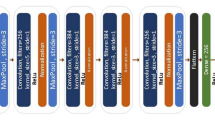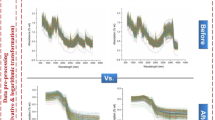Abstract
Purpose
Soil environmental monitoring is crucial for crop production, urban planning, and human health. However, the existing monitoring methods are inefficient and costly. In order to improve the efficiency of soil monitoring, a multi-indicator concentration detection method based on a new modified spectrometer technology (MST) was proposed.
Materials and methods
MST, a method that combines high-throughput experiments (HTE) and machine learning (ML), was proposed to determine various substances in a complex environment and exhibited features of large measurement throughput and high prediction accuracy. Soil is a classic complex chemical system in nature, so we want to try to apply MST to soil monitoring projects. In this study, about 14,400 holographic scattering spectroscopy (HSS) images were captured using the MST and used to train 3 deep neural networks (ResNet-50, Inception V1, and SqueezeNet V1.1). These models were optimized by adjusting parameters and hyperparameters.
Results and discussion
The concentration prediction model based on ResNet-50 has fast convergence speed and a good learning effect. The model can simultaneously detect eight indicators. The best evaluation results achieved coefficient of determination (R2) = 0.996, root mean square error (RMSE) = 0.758, and mean relative error (MRE) < 5% in the test set.
Conclusions
The results show that MST is superior to the previous studies published by EPA, and demonstrate some potential in introducing ML to soil environmental monitoring.





Similar content being viewed by others
References
Asadi M, Fathzadeh A, Kerry R et al (2021) Prediction of river suspended sediment load using machine learning models and geo-morphometric parameters. Arab J Geosci 14:1926. https://doi.org/10.1007/s12517-021-07922-6
Axtell TW, Overbey LA, Woerner L (2018) Machine learning in complex systems. In Ground/Air Multisensor Interoperability, Integration, and Networking for Persistent ISR IX. SPIE, pp 39–44. https://doi.org/10.1117/12.2309547
Azrour M, Mabrouki J, Fattah G, Guezzaz A, Aziz F (2022) Machine learning algorithms for efficient water quality prediction. Model Earth Syst Environ 8:2793–2801. https://doi.org/10.1007/s40808-021-01266-6
Batista GE, Prati RC, Monard MC (2004) A study of the behavior of several methods for balancing machine learning training data. SIGKDD Explorations 6:20–29. https://doi.org/10.1145/1007730.1007735
Bazoobandi A, Emamgholizadeh S, Ghorbani H (2022) Estimating the amount of cadmium and lead in the polluted soil using artificial intelligence models. Eur J Environ Civ Eng 26(3):933–951. https://doi.org/10.1080/19648189.2019.1686429
Cai HT, Liu J, Chen JY, Zhou KH, Pi J, Xia LR (2021) Soil nutrient information extraction model based on transfer learning and near infrared spectroscopy. Alexandria Eng J 60:2741–2746. https://doi.org/10.1016/j.aej.2021.01.014
Duan Q, Lee J (2020) Fast-developing machine learning support complex system research in environmental chemistry. New J Chem 44:1179–1184. https://doi.org/10.1039/C9NJ05717J
Duan Q, Hu Y, Zheng S, Lee J, Chen J, Bi S, Xu Z (2020) Machine learning for mixture toxicity analysis based on high-throughput printing technology. Talanta 207:120299. https://doi.org/10.1016/j.talanta.2019.120299
Duan Q, Lee J, Chen J, Feng Y, Luo R, Wang C, Bi S, Liu F, Wang W, Huang Y (2021a) Image learning to accurately identify complex mixture components. Analyst 146:5942–5950. https://doi.org/10.1039/D1AN01288F
Duan Q, Xu Z, Zheng S, Chen J, Feng Y, Run L, Lee J (2021b) Machine learning based on holographic scattering spectrum for mixed pollutants analysis. Anal Chim Acta 1143:298–305. https://doi.org/10.1016/j.aca.2020.10.060
Duckworth OW, Polizzotto ML, Thompson A, Fies J (2022) Bringing soil chemistry to environmental health science to tackle soil contaminants. Front Environ Sci 10:981607. https://doi.org/10.3389/fenvs.2022.981607
Feng J, Liu J, Pan C (2018) Complex behavior recognition based on convolutional neural network: A survey. In 2018 14th international conference on mobile ad-hoc and sensor networks (MSN), 103–108. https://doi.org/10.1109/MSN.2018.00024
Gauthama BU, Narayana B, Sarojini BK et al (2020) Nitrate/Nitrite determination in water and soil samples accompanied by in situ azo dye formation and its removal by superabsorbent cellulose hydrogel. SN Appl Sci 2:1225. https://doi.org/10.1007/s42452-020-3016-5
Huang Y, Chen J, Duan Q, Feng Y, Luo R, Wang W, Liu F, Bi S, Lee J (2022) A fast antibiotic detection method for simplified pretreatment through spectra-based machine learning. Front Environ Sci Eng 16:1–12. https://doi.org/10.1007/s11783-021-1472-9
Iandola FN, Han S, Moskewicz MW, Ashraf K, Dally WJ, Keutzer K (2016) SqueezeNet: AlexNet-level accuracy with 50x fewer parameters and < 0.5 MB model size. arXiv preprint arXiv:602.07360. https://doi.org/10.48550/arXiv.1602.07360
Jutakanoke R, Intaravicha N, Charoensuksai P et al (2023) Alleviation of soil acidification and modification of soil bacterial community by biochar derived from water hyacinth Eichhornia crassipes. Sci Rep 13:397. https://doi.org/10.1038/s41598-023-27557-9
Li B, He Y (2018) An improved ResNet based on the adjustable shortcut connections. IEEE Access 6:18967–18974. https://doi.org/10.1109/ACCESS.2018.281460
Li X-Y, Fan P-P, Liu Y, Hou G-L, Wang Q, Lv M-R (2019) Prediction results of different modeling methods in soil nutrient concentrations based on spectral technology. J Appl Spectrosc 86:765–770. https://doi.org/10.1007/s10812-019-00891-5
Liao Y, Yu N, Tian D, Wang Y, Li S, Li Z (2020) Toward embedded sensing automation and miniaturization for portable smart cost-effective algae monitor. IEEE Sens J 21:5230–5239. https://doi.org/10.1109/JSEN.2020.3031362
Liu Z, Li X, Xiao G, Chen B, He M, Hu B (2017) Application of inductively coupled plasma mass spectrometry in the quantitative analysis of biomolecules with exogenous tags: a review. TrAC 93:78–101. https://doi.org/10.1016/j.trac.2017.05.008
Luo R, Ma G, Bi S, Duan Q, Chen J, Feng Y, Liu F, Lee J (2020) Machine learning for total organic carbon analysis of environmental water samples using high-throughput colorimetric sensors. Analyst 145:2197–2203. https://doi.org/10.1039/C9AN02267H
Ma G, Ren J, Tao L et al (2023) Effectiveness and potential mechanism of hydrothermal modification of attapulgite for cadmium passivation in soil. Int J Environ Sci Technol. https://doi.org/10.1007/s13762-023-05124-z
Mylavarapu R, Obreza T et al (2014) Extraction of soil nutrients using Mehlich-3 reagent for acid-mineral soils of Florida. IFAS Extension, pp 407–413. https://edis.ifas.ufl.edu/publication/SS620
Odebiri O, Mutanga O, Odindi J, Peerbhay K, Dovey S (2020) Predicting soil organic carbon stocks under commercial forest plantations in KwaZulu-Natal province, South Africa using remotely sensed data. Gisci Remote Sens 57:450–463. https://doi.org/10.1080/15481603.2020.1731108
Odebiri O, Mutanga O, Odindi J, Naicker R, Masemola C, Sibanda M (2021) Deep learning approaches in remote sensing of soil organic carbon: a review of utility, challenges, and prospects. Environ Monit Assess 193:1–18. https://doi.org/10.1007/s10661-021-09561-6
Padarian J, Minasny B, McBratney AB (2019) Using deep learning to predict soil properties from regional spectral data. Geoderma Reg 16:e00198. https://doi.org/10.1016/j.geodrs.2018.e00198
Pásztor L, Takács K, Mészáros J, Szatmári G, Árvai M, Tóth T, Barna G, Koós S, Kovács ZA, László P et al (2023) Indirect prediction of salt affected soil indicator properties through habitat types of a natural saline grassland using unmanned aerial vehicle imagery. Land 12(8):1516. https://doi.org/10.3390/land12081516
Paul J, Jacobs P, Weiss P, Maier W (2004) Combinatorial discovery of new catalysts for the selective oxidation of isobutane. Appl Catal A-Gen 265:185–193. https://doi.org/10.1016/j.apcata.2004.01.023
Peng J, Ji W, Ma Z, Li S, Chen S, Zhou L, Shi Z (2016) Predicting total dissolved salts and soluble ion concentrations in agricultural soils using portable visible near-infrared and mid-infrared spectrometers. Biosyst Eng 152:94–103. https://doi.org/10.1016/j.biosystemseng.2016.04.015
Somarathna P, Minasny B, Malone BP (2017) More data or a better model? Figuring out what matters most for the spatial prediction of soil carbon. Soil Sci 81:1413–1426. https://doi.org/10.1021/acs.est.1c02479
Steven S, Bentley J, Dubra A (2019) Design of two spherical mirror unobscured relay telescopes using nodal aberration theory. Opt Express 27:11205–11226. https://doi.org/10.1364/OE.27.011205
Szegedy C, Liu W, Jia PY, Reed S, Anguelov D, Erhan D, Vanhoucke V, Rabinovich A (2015) “In going deeper with convolutions.” In 2015 IEEE conference on computer vision and pattern recognition (CVPR), Boston, Massachusetts, pp 1–9. https://doi.org/10.1109/CVPR.2015.7298594
Talaat FM (2023) Crop yield prediction algorithm (CYPA) in precision agriculture based on IoT techniques and climate changes. Neural Comput Appl 35:17281–17292. https://doi.org/10.1007/s00521-023-08619-5
Teng Y, Wu J, Lu S, Wang Y, Jiao X, Song L (2014) Soil and soil environmental quality monitoring in China: a review. Environ Int 69:177–199. https://doi.org/10.1016/j.envint.2014.04.014
Trontelj ml. J., Chambers O. (2021) Machine learning strategy for soil nutrients prediction using spectroscopic method. Sensors 21(12):4208. https://doi.org/10.3390/s21124208
Tsakiridis NL, Keramaris KD, Theocharis JB, Zalidis GC (2020) Simultaneous prediction of soil properties from VNIR-SWIR spectra using a localized multi-channel 1-D convolutional neural network. Geoderma 367:114208. https://doi.org/10.1016/j.geoderma.2020.114208
Wang H, Yilihamu Q, Yuan M, Bai H, Xu H, Wu J (2020) Prediction models of soil heavy metal (loid)s concentration for agricultural land in Dongli: a comparison of regression and random forest. Ecol Indic 119:106801. https://doi.org/10.1016/j.ecolind.2020.106801
Wang W, Luo R, Duan Q, Feng Y, Chen J, Huang Y, Bi S, Liu F, Lee J (2021) Direct quantification of mixed organic acids based on spectral image with deep learning. ChemistrySelect 6:3540–3547. https://doi.org/10.1002/slct.202100444
Welch CJ (2019) High throughput analysis enables high throughput experimentation in pharmaceutical process research. React Chem Eng 4:1895–1911. https://doi.org/10.1039/C9RE00234K
Wijewardane NK, Ge Y, Wills S, Loecke T (2016) Prediction of soil carbon in the conterminous United States: visible and near infrared reflectance spectroscopy analysis of the rapid carbon assessment project. Soil Sci Soc Am J 80:973–982. https://doi.org/10.2136/sssaj2016.02.0052
Xia F, Fan T, Chen Y, Ding D, Wei J, Jiang D, Deng S (2022) Prediction of heavy metal concentrations in contaminated sites from portable X-ray fluorescence spectrometer data using machine learning. Processes 10:536. https://doi.org/10.3390/pr10030536
Xie H-T, Yang XM, Drury CF, Yang JY, Zhang XD (2011) Predicting soil organic carbon and total nitrogen using mid- and near-infrared spectra for Brookston clay loam soil in Southwestern Ontario, Canada. Can J Soil Sci 91:53–63. https://doi.org/10.4141/CJSS10029
Xu X, Du C, Ma F, Shen Y, Wu K, Liang D, Zhou J (2019) Detection of soil organic matter from laser-induced breakdown spectroscopy (LIBS) and mid-infrared spectroscopy (FTIR-ATR) coupled with multivariate techniques. Geoderma 355:113905. https://doi.org/10.1016/j.geoderma.2019.113905
Yang H, Huang K, Zhang K, Weng Q, Zhang H, Wang F (2021) Predicting heavy metal adsorption on soil with machine learning and mapping global distribution of soil adsorption capacities. Environ 55:14316–14328. https://doi.org/10.1021/acs.est.1c02479
Yuan Q, Shen H, Li T, Li Z, Li S, Jiang Y, Xu H, Tan W, Yang Q, Wang J (2020) Deep learning in environmental remote sensing: achievements and challenges. Remote Sens Environ 241:111716. https://doi.org/10.1016/j.rse.2020.111716
Zheng Y, Lee J, Duan Q, Chen H, Yan X, Zhang J, Wang L (2017) A novel encoded recording strategy of complex chemical system. Chem Lett 46:360–363. https://doi.org/10.1246/cl.161110
Funding
This work is supported by the National Natural Science Foundation of China (No. 50309011), the Scientific Reuter Foundation for the Returned Overseas Chinese Scholars (No. 08501041585), the Natural Science Basic Research Plan in the Shaanxi Province of China (No. 2021JQ436), and the Scientific Research Program Funded by Shaanxi Provincial Education Department (No. 22JK0583).
Author information
Authors and Affiliations
Corresponding author
Ethics declarations
Conflict of interest
The authors declare no competing interests.
Additional information
Responsible editor: Yan He
Publisher's Note
Springer Nature remains neutral with regard to jurisdictional claims in published maps and institutional affiliations.
Supplementary Information
Below is the link to the electronic supplementary material.
Rights and permissions
Springer Nature or its licensor (e.g. a society or other partner) holds exclusive rights to this article under a publishing agreement with the author(s) or other rightsholder(s); author self-archiving of the accepted manuscript version of this article is solely governed by the terms of such publishing agreement and applicable law.
About this article
Cite this article
Zhao, Y., Feng, Y., Liu, L. et al. Simultaneous quantification of multiple chemical properties of soil solution using smart spectroscopy. J Soils Sediments 24, 1694–1703 (2024). https://doi.org/10.1007/s11368-024-03747-4
Received:
Accepted:
Published:
Issue Date:
DOI: https://doi.org/10.1007/s11368-024-03747-4




